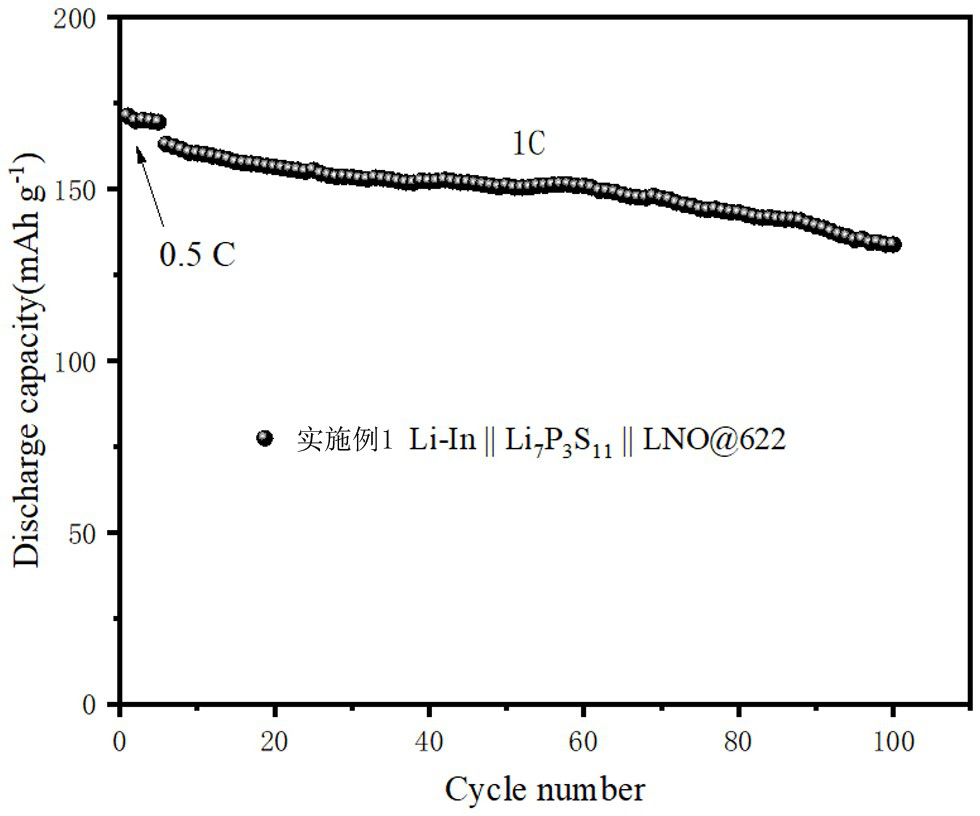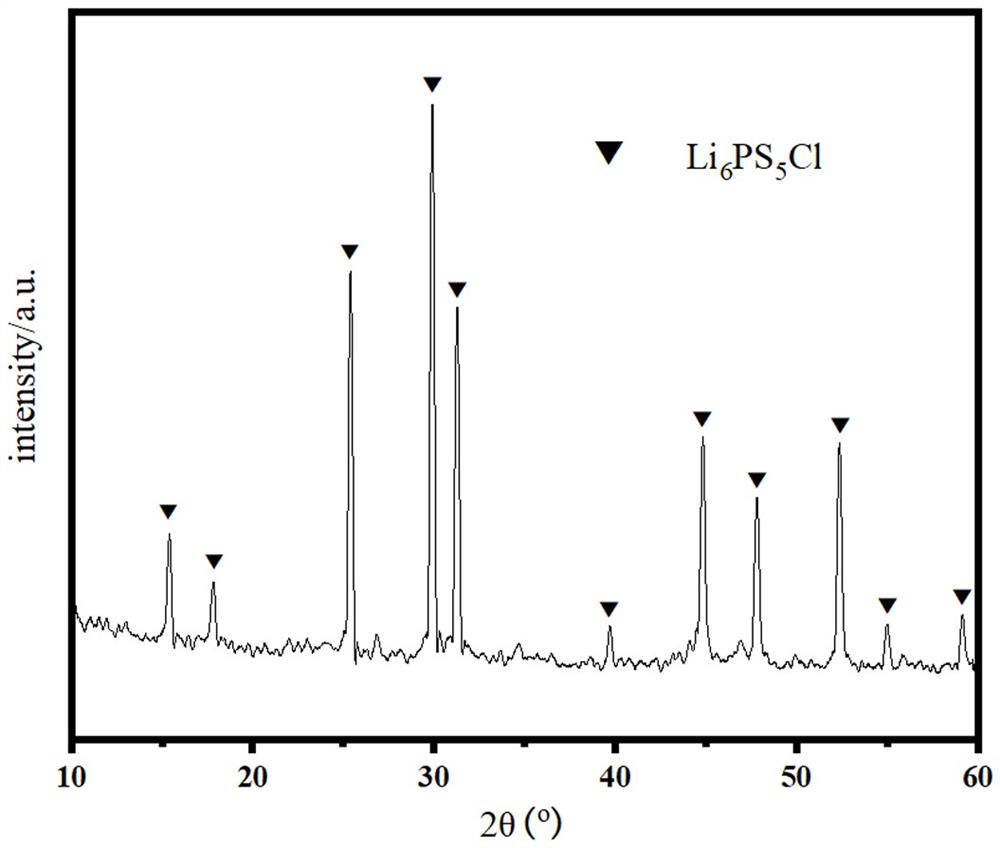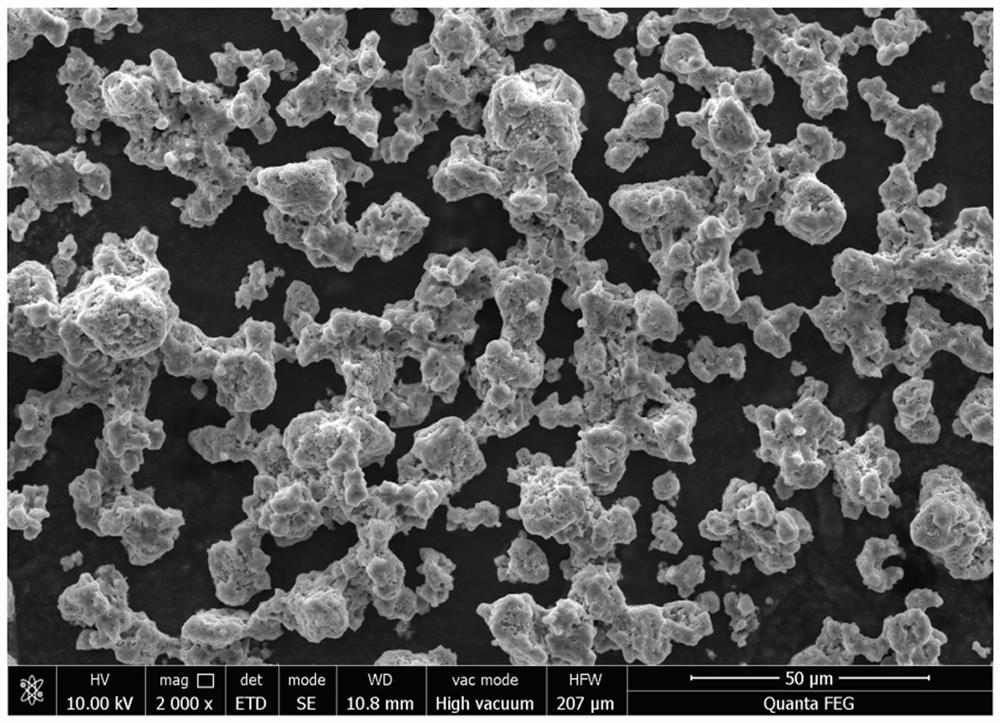Method for synthesizing sulfide solid electrolyte
A technology of solid electrolytes and sulfides, applied in solid electrolytes, non-aqueous electrolytes, circuits, etc., can solve the problems of low ionic conductivity of sulfide solid electrolytes, limitations of sulfide solid electrolytes, etc.
- Summary
- Abstract
- Description
- Claims
- Application Information
AI Technical Summary
Problems solved by technology
Method used
Image
Examples
Embodiment 1
[0036] Under a dry argon atmosphere, according to Li 7 P 3 S 11 Composition ratio, weigh 0.8983g of lithium powder, 2.1373g of sulfur powder and 6.1644g of phosphorus pentasulfide to form a mixture with a total mass of 9.2g, of which the excess of sulfur powder is 3%, and place it in a ball mill tank for plasma ball milling for 4h. Under the protection of a dry nitrogen atmosphere, the ball-milled powder was heat-treated at 550°C for 1 hour, and then rapidly cooled to room temperature after heat treatment. The calcined powder was crushed by shearing to obtain Li 7 P 3 S 11 electrolyte. The Li measured by the electrochemical workstation 7 P 3 S 11 The electrolyte has an ionic conductivity of 1.9 mS / cm at 25 °C.
Embodiment 2
[0038] Under a dry argon atmosphere, according to Li 6 P.S. 5 Cl composition ratio, weigh 1.2358g of lithium powder, 2.9973g of sulfur powder, 3.9574g of phosphorus pentasulfide and 1.5095g of anhydrous lithium chloride to form a mixture with a total mass of 9.7g, place it in a ball mill tank for plasma ball milling for 3h, wherein the excess of sulfur powder is 5 %. Under the protection of a dry nitrogen atmosphere, the ball-milled powder was heat-treated at 450°C for 2 hours, and then rapidly cooled to room temperature after heat treatment. The calcined powder was crushed by shearing to obtain Li 6 P.S. 5 Cl electrolyte. The Li measured by the electrochemical workstation 6 P.S. 5 The ionic conductivity of the Cl electrolyte is 3.2 mS / cm at 25 °C.
Embodiment 3
[0040] Under a dry argon atmosphere, according to Li 9.54 Si 1.74 P 1.44 S 11.7 Cl0.3 Composition ratio, weigh 1.1833g lithium powder, 2.8694g sulfur powder, 2.9601g silicon disulfide, 2.9525g phosphorus pentasulfide and 0.2347g anhydrous lithium chloride to form a mixture with a total mass of 10.2g, place it in a ball mill tank for plasma ball milling for 3h, Among them, the excess of sulfur powder is 3%. Under the protection of a dry argon atmosphere, the ball-milled powder was heat-treated at 550°C for 1 hour, and then rapidly cooled to room temperature after heat treatment. The calcined powder is crushed by grinding to obtain Li 9.54 Si 1.74 P 1.44 S 11.7 Cl 0.3 electrolyte. The Li measured by the electrochemical workstation 9.54 Si 1.74 P 1.44 S 11.7 Cl 0.3 The ionic conductivity of the electrolyte is 3.0 mS / cm at 25 °C.
PUM
| Property | Measurement | Unit |
|---|---|---|
| electrical conductivity | aaaaa | aaaaa |
| electrical conductivity | aaaaa | aaaaa |
| electrical conductivity | aaaaa | aaaaa |
Abstract
Description
Claims
Application Information
 Login to View More
Login to View More - R&D
- Intellectual Property
- Life Sciences
- Materials
- Tech Scout
- Unparalleled Data Quality
- Higher Quality Content
- 60% Fewer Hallucinations
Browse by: Latest US Patents, China's latest patents, Technical Efficacy Thesaurus, Application Domain, Technology Topic, Popular Technical Reports.
© 2025 PatSnap. All rights reserved.Legal|Privacy policy|Modern Slavery Act Transparency Statement|Sitemap|About US| Contact US: help@patsnap.com



